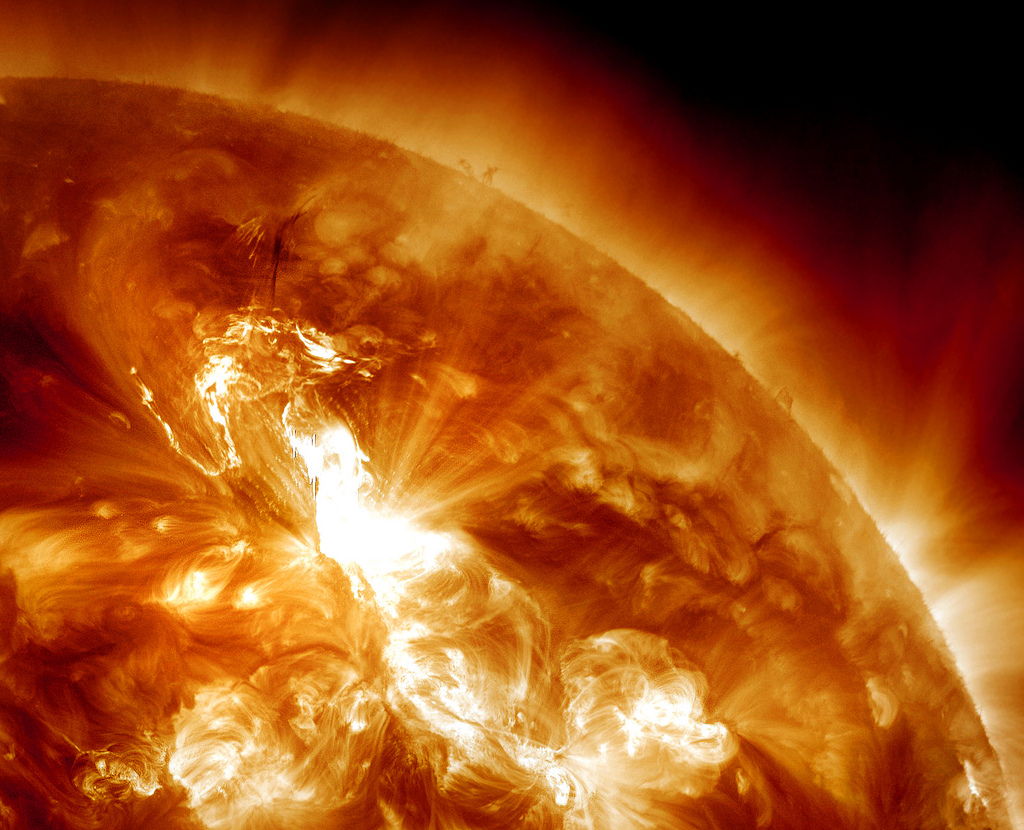Astronauts in Space Safe from Huge Solar Radiation Storm

An intense solar flare unleashed the biggest radiation storm in years today (Jan. 23), but astronauts aboard the International Space Station are not in any danger, NASA officials say.
The sun eruption triggered the most powerful radiation storm since 2005 in a wave of charged particles that is expected to hit our planet Tuesday (Jan. 24) at around 9 a.m. EST (1400 GMT), according to experts at the Space Weather Prediction Center, which is operated by the National Oceanic and Atmospheric Administration (NOAA).
NASA scientists also routinely monitor space weather conditions in order to protect astronauts and hardware in orbit from harmful radiation, and today's solar storm is no exception, agency officials said.
"The flight surgeons have reviewed the space weather forecasts for the flare and determined that there are no expected adverse effects or actions required to protect the on-orbit crew," NASA spokesman Kelly Humphries told SPACE.com.
The solar flare erupted this morning at 0359 GMT (which corresponds to late Sunday, Jan. 22 at 10:59 p.m. EST), triggering a solar explosion known as a coronal mass ejection that sent a stream of charged particles into space. When these charged particles hit Earth they stream down the planet's magnetic field lines to create so-called geomagnetic storms that can supercharge Earth's auroras (also known as the northern and southern lights).
But space weather can also have negative effects, such as interfering with power grids and communications infrastructure on Earth, and disrupting satellites and other spacecraft in orbit.
According to the skywatching site Spaceweather.com, today's coronal mass ejection "will deliver a strong glancing blow to Earth's magnetic field on Jan. 24-25 as it sails mostly north of our planet."
Get the Space.com Newsletter
Breaking space news, the latest updates on rocket launches, skywatching events and more!
In response, NOAA's Space Weather Prediction Center has issued a geomagnetic storm watch, and the agency's deputy, Kathy Sullivan, said that polar flights are expected to be re-routed.
Editor's note: If you snap an amazing northern lights photo, or other skywatching image, and would like to share it for a possible story or gallery, please contact managing editor Tariq Malik at tmalik@space.com.
OurAmazingPlanet staff writer Brett Israel (@btisrael) contributed to this report from New Orleans, La. Follow SPACE.com for the latest in space science and exploration news on Twitter @Spacedotcom and on Facebook.
Join our Space Forums to keep talking space on the latest missions, night sky and more! And if you have a news tip, correction or comment, let us know at: community@space.com.

Space.com is the premier source of space exploration, innovation and astronomy news, chronicling (and celebrating) humanity's ongoing expansion across the final frontier. Originally founded in 1999, Space.com is, and always has been, the passion of writers and editors who are space fans and also trained journalists. Our current news team consists of Editor-in-Chief Tariq Malik; Editor Hanneke Weitering, Senior Space Writer Mike Wall; Senior Writer Meghan Bartels; Senior Writer Chelsea Gohd, Senior Writer Tereza Pultarova and Staff Writer Alexander Cox, focusing on e-commerce. Senior Producer Steve Spaleta oversees our space videos, with Diana Whitcroft as our Social Media Editor.









